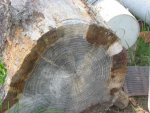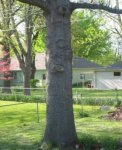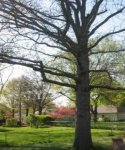Andrew Gingo
Member
- Messages
- 17
Hi All
This seems like the right tread to ask this question/get information. Had to cut down a large 36" diameter oak in my yard a couple years ago. Three of the pictures are of what is left. The stump, approximate 8' length which did not finish cutting and the end grain on the 8' length. It has been lying on the ground for about 2 years. All the rest was cut and split for firewood.
Now an even larger approximate 40" diameter (measurement taken about 4' off the ground) is almost dead. A friend of mine told me he has a chainsaw guide which uses a 2 X 8 as a guide to cut boards from a log. I have never used one of these. Would it be worth it to attempt to cut up the tree. I also have a planer which fits up to 15" wide and 6" thick stock and a 10" table saw. My friend said he has a large band saw but since he has it in his basement the largest pieces we could cut is determined by what we could carry down his stairs or slide in through the basement window (two people carrying).
Any suggestions or tips since I have never tried to mill my own lumber (if you could call it that).
Since it close to power lines I will call the power company and tell them I plan on cutting it down myself. When I did that with the last tree the power company came out and cut it down. They cut off the all large branches, top it and than cut down the trunk and I must cut it up and dispose of it myself.
So it is either firewood or I attempt cutting it into slabs which means it may still wind up as firewood anyway.
All comments welcome. Thank you
Andy





This seems like the right tread to ask this question/get information. Had to cut down a large 36" diameter oak in my yard a couple years ago. Three of the pictures are of what is left. The stump, approximate 8' length which did not finish cutting and the end grain on the 8' length. It has been lying on the ground for about 2 years. All the rest was cut and split for firewood.
Now an even larger approximate 40" diameter (measurement taken about 4' off the ground) is almost dead. A friend of mine told me he has a chainsaw guide which uses a 2 X 8 as a guide to cut boards from a log. I have never used one of these. Would it be worth it to attempt to cut up the tree. I also have a planer which fits up to 15" wide and 6" thick stock and a 10" table saw. My friend said he has a large band saw but since he has it in his basement the largest pieces we could cut is determined by what we could carry down his stairs or slide in through the basement window (two people carrying).
Any suggestions or tips since I have never tried to mill my own lumber (if you could call it that).
Since it close to power lines I will call the power company and tell them I plan on cutting it down myself. When I did that with the last tree the power company came out and cut it down. They cut off the all large branches, top it and than cut down the trunk and I must cut it up and dispose of it myself.
So it is either firewood or I attempt cutting it into slabs which means it may still wind up as firewood anyway.
All comments welcome. Thank you
Andy





Last edited by a moderator:


